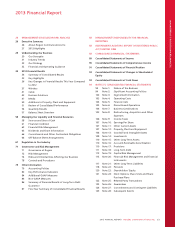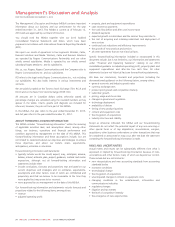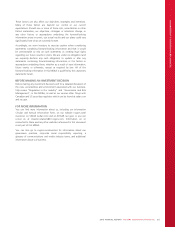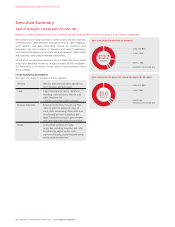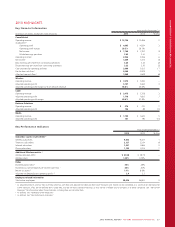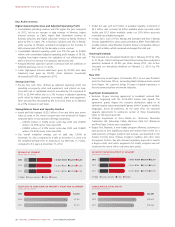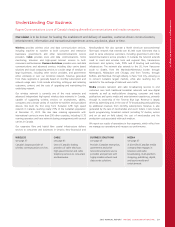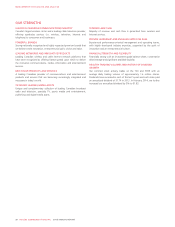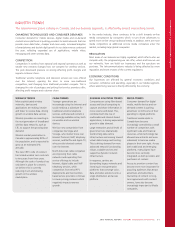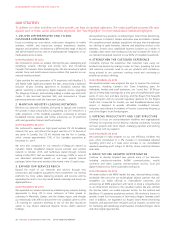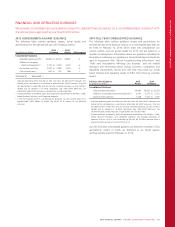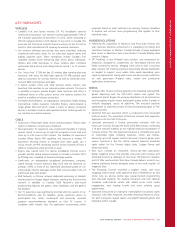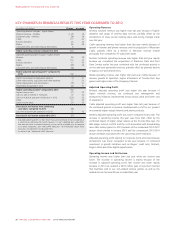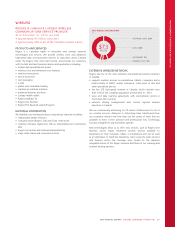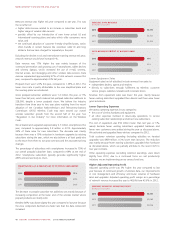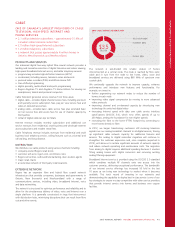Rogers 2013 Annual Report Download - page 35
Download and view the complete annual report
Please find page 35 of the 2013 Rogers annual report below. You can navigate through the pages in the report by either clicking on the pages listed below, or by using the keyword search tool below to find specific information within the annual report.
MANAGEMENT’S DISCUSSION AND ANALYSIS
INDUSTRY TRENDS
The telecommunications industry in Canada, and our business segments, is affected by several overarching trends.
CHANGING TECHNOLOGIES AND CONSUMER DEMANDS
Consumer demand for mobile devices, digital media and on-demand
content across platforms is pushing providers to build networks that can
provide more data faster, cheaper and more easily. Increased adoption
of smartphones and double digit growth in our data revenue continued
this year, reflecting expanded use of applications, mobile video,
messaging and other wireless data.
COMPETITION
Competition in wireless from national and regional operators as well as
smaller new entrants changes how we compete for wireless services.
This puts downward pressure on pricing affecting profit margins and
impacts customer churn.
Traditional wireline telephone and television services are now offered
over the Internet, opening the door to more non-traditional
competitors, and changing how traditional providers compete. This is
changing the mix of packages and pricing that service providers offer,
affecting profit margins and customer churn.
In the media industry, there continues to be a shift towards on-line
media consumption by consumers which in turn drives advertisers to
spend more on-line versus traditional media. In addition, there are more
media competitors as additional on-line media companies enter the
market, including large global companies.
REGULATION
Most areas of our business are highly regulated, which affects who we
compete with, the programming we can offer, where and how we use
our networks, how we build our businesses and the spectrum we
purchase. The telecommunications industry is being affected by more
regulation and more reviews of the current regulations.
ECONOMIC CONDITIONS
Our businesses are affected by general economic conditions and
consumer confidence and spending, especially in our Media segment,
where advertising revenue is directly affected by the economy.
WIRELESS TRENDS
More sophisticated wireless
networks, devices and
applications are making it easier
and faster to receive data, driving
growth in wireless data services.
Wireless providers are investing in
the next generation of broadband
wireless data networks, such as
LTE, to support the growing data
demand.
Wireless market penetration in
Canada is approximately 80%of
the population, and is expected to
grow at an estimated 2%
annually.
The new CRTC code of conduct
has limited wireless term contracts
to two years from three years.
Although the code of conduct has
only been in place for a month,
we believe this is currently
reducing churn and slowing
growth in the wireless
marketplace.
CABLE TRENDS
Younger generations are
increasingly using the Internet and
social media as a substitute for
traditional wireline telephone
services, and televised content is
increasingly available online, both
on wireline and on wireless
devices.
We face new competition from
companies like Skype and
Vonage, who market Voice over
Internet Protocol (VoIP) telephony
services, and Netflix and Apple TV,
who provide televised content
over the Internet.
North American cable companies
are improving their cable
networks and expanding their
service offerings to include
Internet, digital cable and VoIP
telephony services, while
competition from telco IPTV
deployments and non-facilities
based service providers continues
to cause pricing pressures which
negatively impacts revenue
growth.
BUSINESS SOLUTIONSTRENDS
Companies are using fibre-based
access and cloud computing to
capture and share information in
more volume and detail. This,
combined with the rise of
multimedia and Internet-based
applications, is driving exponential
growth in data demand.
Large enterprises and all levels of
government are dramatically
transforming data centre
infrastructure and moving toward
virtual data storage and hosting.
This is driving demand for more
advanced network functionality,
robust, scalable services and
supportive dynamic network
infrastructure.
In response, carriers are
dismantling legacy networks and
investing in next generation
platforms that converge voice,
data and video solutions onto a
single distribution and access
platform.
MEDIA TRENDS
Consumer demand for digital
media, mobile devices and on-
demand content is pushing
advertisers to shift some of their
spending to digital platforms.
Traditional media assets in
Canada have become
increasingly controlled by a small
number of competitors with
significant scale and financial
resources, while technology has
allowed new entrants and even
individuals to become media
players in their own right. Across
both traditional and emerging
platforms, many players have
become more vertically
integrated, as both providers and
purchasers of content.
Access to premium content has
become even more important for
acquiring audiences that attract
advertisers and subscribers.
Ownership of content or long-
term agreements with content
owners, have also become
increasingly important to Media
companies.
2013 ANNUAL REPORT ROGERS COMMUNICATIONS INC. 31




